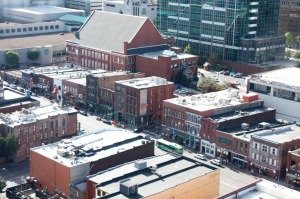 From Better! Cities & Towns writer Joe Nickol: "Recently I have been working in Nashville, Tennessee, meeting with, among many others, representatives from the visual arts, music, and business communities to discuss ways that new downtown development can reinforce Nashville's legacy as one of the most creative cities in North America.
"The central question of this exploration is what about this city allows Nashvillians to use it to develop explosive musical talent generation after generation while developing brains at an equally impressive rate? If not for key physical attributes, Nashvillians could not have used their city in a highly adaptive and productive manner. These attributes include:
From Better! Cities & Towns writer Joe Nickol: "Recently I have been working in Nashville, Tennessee, meeting with, among many others, representatives from the visual arts, music, and business communities to discuss ways that new downtown development can reinforce Nashville's legacy as one of the most creative cities in North America.
"The central question of this exploration is what about this city allows Nashvillians to use it to develop explosive musical talent generation after generation while developing brains at an equally impressive rate? If not for key physical attributes, Nashvillians could not have used their city in a highly adaptive and productive manner. These attributes include:
"Affordable, hyper-adaptive buildings that age well. Nashville has a diverse stock of buildings that were practically constructed and whose simplicity has allowed them to adapt to changing market needs through time. Although, like most other cities, newer buildings largely fail to abide by this pattern, they have pulled uses out of the aging stock to allow creative reuse at price points that allow musicians and startups to access and afford them. This flexibility in use affords great resilience to economic changes and positions the city well to take take advantage of unforeseen opportunities.
"Compression, Connectivity, and Inter-Mixing. Practical, well-constructed buildings are not enough. Cities such as Nashville thrive on compression and interconnectivity between buildings, places, and users. This allows strangers and acquaintances to come together comfortably and organically to perform and exchange ideas. This is the birthplace of technology (in the classic sense of the word) and the hotbed of innovation where new ideas are constantly emerging from old ones.
"But not all cities are like the music industry. Many are like corporations. They tend to tense up as they grow and age. This generally tilts policy and behavior toward protecting largeness at the expense of the more resilient scale of the tinkerers, innovators, and startups. The effects of doing so can be seen in our urban landscapes when many small parcels and buildings get assembled into creating super-blocks and mega structures." Full article here.
